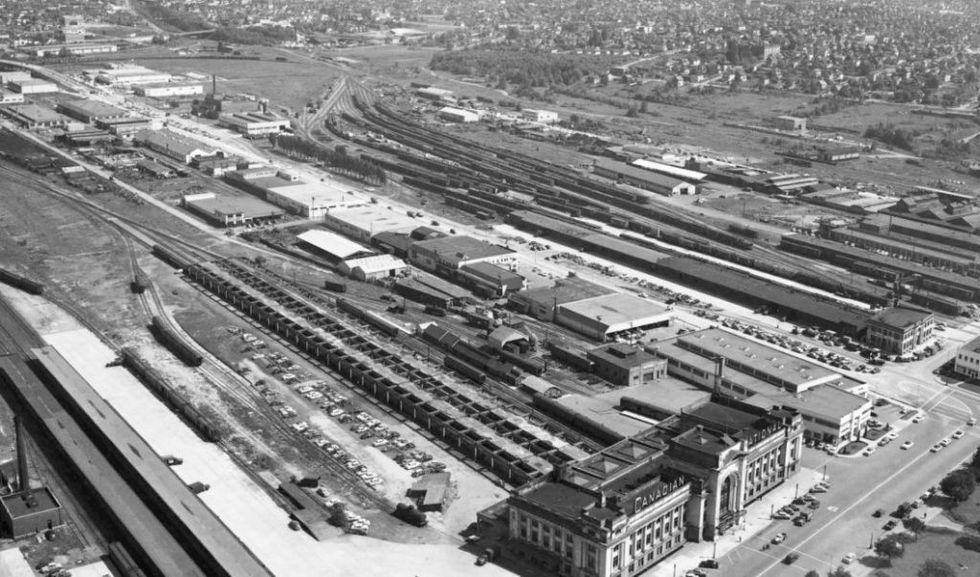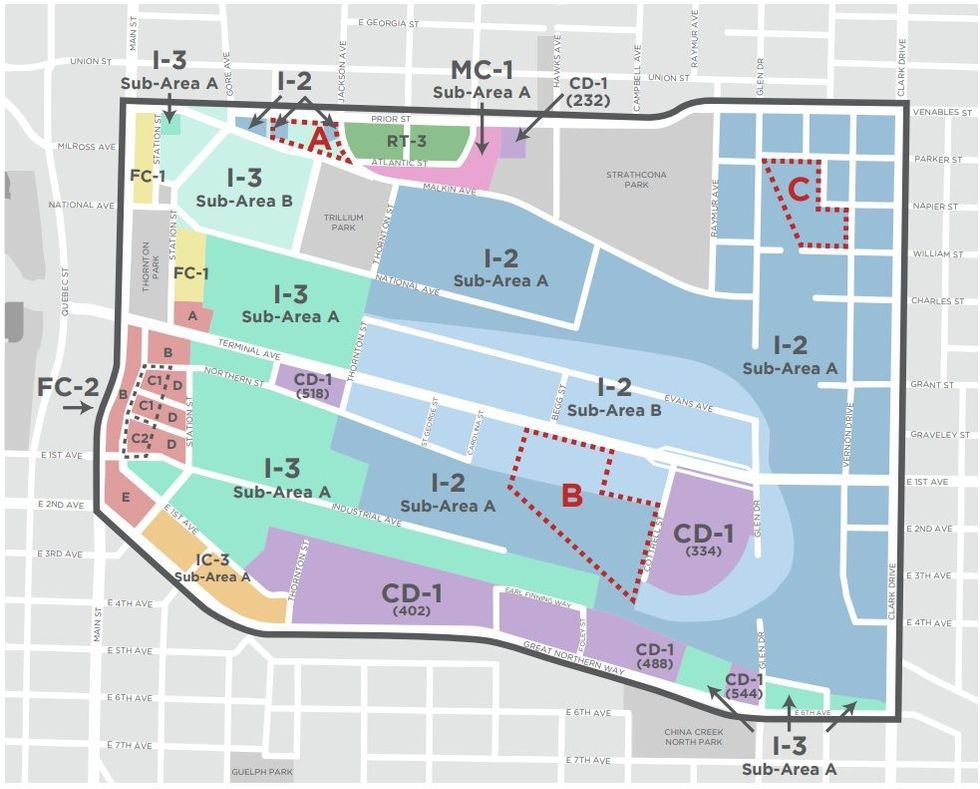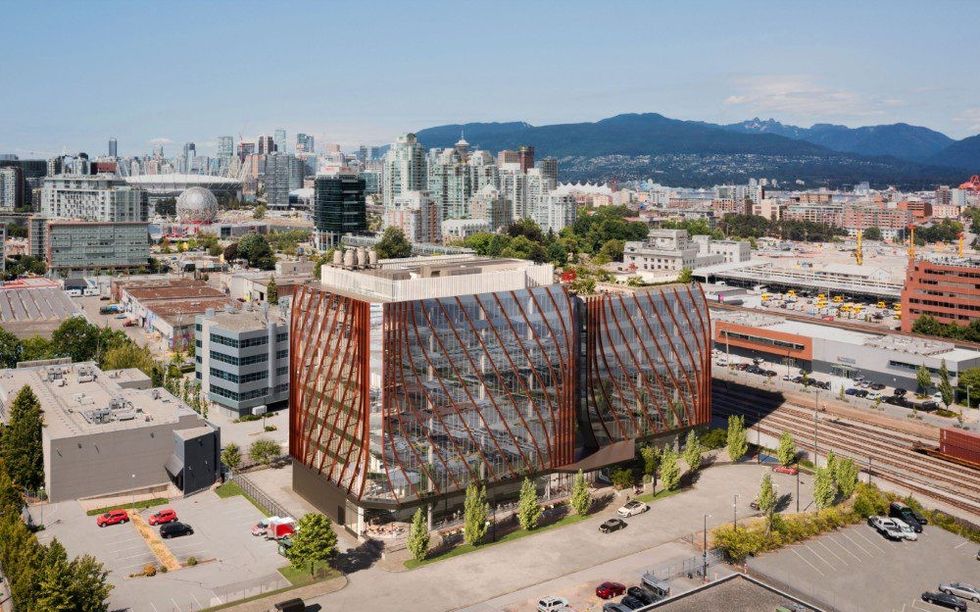On May 17, 2017, the City of Vancouver approved the False Creek Flats Plan, setting the stage for the historic 450-acre district to evolve once more and become -- the City hoped -- an invaluable economic zone.
Originally a mudflat -- coastal wetlands formed by river sediments -- on the eastern end of False Creek, the groundwork for the industrial importance of the False Creek Flats was first laid in the 1910s, after the Great Northwest Railway and Canadian Northern Railway established terminals in the area.
"While the rail companies moved quickly to establish their new railyards and distribution networks, it took much longer for the Flats to establish itself as a legitimate alternative to the more central business locations," reads a City of Vancouver area profile. "With the industrial lands in the more urban sites of Gastown and Yaletown nearing capacity, companies who still wanted to operate near the centre of the city began to look towards the larger vacant sites in the Flats to accommodate their spatial needs."
Shortly after the False Creek Flats established itself, however, came the car boom -- beginning around 1945 -- and industry began to shift away from railways and towards automobiles. The rest of the 20th century then saw the City developing plans that anticipated the removal of railyards and growth in the area that went beyond just the movement of goods.

Fast-forward to the mid-2010s, and the False Creek Flats had become home to nearly 600 businesses, ranging from breweries to chocolatiers and bio-tech companies to artists, with enough opportunities to employ nearly 8,000 people.
Once more, however, the tides began to turn. The Flats' proximity to the Port of Vancouver -- Canada's gateway to Asia -- was now less and less critical for new businesses in the area, which became more and more enamored with the proximity to the downtown core. Infrastructure and transit development in the area also contributed to an improved economic landscape, stoking interest and raising land values in the Flats.
According to the City, "as it stands today [in 2017], only 10% of land in Vancouver prohibits residential development, yet these areas are home to roughly half of all of our jobs. Without strong policy, these lands would quickly disappear as the discrepancy in land values leaves our employment lands worth only a fraction of our residential districts."
As an example, the City noted that industrial land along the Fraser River had a value of about $35 per sq. ft, compared to nearly $3,000 per sq. ft in Coal Harbour, which itself was formerly a railyard.
The False Creek Flats Plan
That City's call for "strong policy" manifested in the False Creek Flats Plan. The original plan was approved by Vancouver City Council -- led by then-Mayor Gregor Robertson's Vision Vancouver -- in May 2017, before large-scale rezoning was then approved a few months later in October.
The Plan outlined a vision for the False Creek Flats over the next 30 years, with the primary objective being to intensify employment opportunities, increasing the number of jobs in the area from 8,000 to at least 30,000. Both the original plan and the rezoning policy that followed hoped to achieve that by doing the following:
- Intensify employment density in well-served transit locations;
- Retain and intensify core industrial economy-serving lands;
- Support a full spectrum of industrial and economic users, from start-up to head-office;
- Develop appropriate bylaws that support innovative economies;
- Encourage amenity contributions to support economic-enabling activities;
- Enable a diverse and interesting landscape that supports active retail and restaurants with goods and services intended for local workers, students and those using the area as an active transportation corridor;
- Provide clarity on future development uses, heights and densities;
- Introduce rezoning opportunities for key character and historic buildings to anchor public life and activity around unique and interesting places; and
- Introduce and intensify residential opportunities aligned with local and regional employment lands policy.
That list of actions has been presented unedited and in the same order the City listed them in a report regarding implementation of the False Creek Flats plan, and the appearance of "residential opportunities" as the last item on the list is indicative of the City's priorities for the Flats, which worried many back in 2017. With there being no evidence that the housing crisis in Vancouver has gotten any better since then, those who were worried then remain so.
At the time, Anne McMullin, President of the Urban Development Institute, told CBC that she believed the City should have done more in terms of housing in the area. "While we were broadly supportive of the False Creek Flats Plan, we did feel there was a missed opportunity," she said, "particularly because of the kind of businesses and the kind of community the City is trying to build there."
Six years later, in a statement to STOREYS, McMullin reiterated the sentiment.
"We recognize the priority that has been given to employment lands in this area, and that they are also regionally regulated. Despite this, we encouraged Council to increase the residential uses in the Plan, add ground-level retail/services to improve vibrancy, and increase the heights and densities permitted. While we are pleased that the Final Plan includes some new opportunities for housing -- especially rental in the Creative District, this only encompasses a small part of the False Creek Flats."
According to the False Creek Flats Plan's section on housing policy (just six pages, compared to 20 pages each for economic development, public spaces, and transportation), approximately 6% of the Flats' 450-acres allows for "some degree" of residential use.

The concerns about housing in the False Creek Flats are also not all the same. Nonetheless, they remain.
Speaking to CBC in the same 2017 article, Green Party City Councillor Adriane Carr said that she was worried that the allowable residential uses would have a negative effect.
"I am worried that the housing, the retail, the restaurants that are included in parts of the area will increase land values and place pressure on industrial lands," she said. "And artists spaces is something we heard a lot from the public. I think our goal is to ensure it is affordable, safe and available. I am not confident that we have enough measures to adequately protect that."
Carr, who was re-elected this past-October, voted against the rezoning plan that was approved in October 2017 for that reason. All this time later, in an interview with STOREYS in late-2022, her concerns have not changed.
"We can't achieve many of the things we want to around livability and affordability if the land values keep going up," Carr said. "[To residential developers], I would say find somewhere else. I don't believe we can lose the industrial lands. I hope they understand not to push for more density, which would raise land values even higher."
On the issue of protecting spaces for artists, Carr reiterated the need for spaces that are affordable, something that she believes is harder to achieve if the area sees more retail and restaurant space.
" Zoning is the biggest measure we have," she said. "Right now, there isn't protective zoning for a specific use, but we can say that when there is development/rezoning that we can focus on [Community Amenity Contributions] with artist spaces. We're lucky to have a great artist community and it's a big part of Vancouver and our culture."
READ: The Entire History of Vancouver's Granville Street, And Its Envisioned Future
The Rising Tide
When it comes to the False Creek Flats, there may not be a more prominent developer than Low Tide Properties, co-founded by Lululemon Athletica founder Chip Wilson. Vice President of Assest Management and Development Adam Mitchell told STOREYS that Low Tide started acquiring sites in the area beginning in 2014, and got more active just before the rezoning in 2017.
Low Tide's website currently lists five properties, all of which are located south of Great Northern Way -- the "South Flatz" as they call it. All five are either office buildings or laboratories, with notable occupants such as video-game company Electronic Arts, a Samsung Research & Development Institute, and biopharmaceutical company Genevant. Their next big project for the South Flatz is Lab 29 on 1629 Scotia Street, an eight-storey life sciences building that's scheduled to be completed in 2026.

"Vancouver has never really had a center of gravity for life sciences," says Mitchell, "and we think the Flats can become a new center of gravity and an extension of the downtown core. We're very committed to Vancouver stepping up on the world stage, we'd love to make it a great city from an economic standpoint, and we view the medical and tech as a driver of that."
But what about housing?
At the moment, there are not many development projects in the False Creek Flats that include residential uses, but there are a few on the way. Archetype by QuadReal and Hungerford Properties, the first project in BC with a tri-mix of residential, office, and light industrial, will be located on 220 E 1st Avenue, on the southern edge of the Flats, near the future Great Northern Way Station that's coming as part of the Broadway Subway Project. On the northern edge of the Flats, near the future new St. Paul's Hospital, two 19-storey rental towers by Strand Development were also approved earlier this month.
Vice Chairman of CBRE Canada Blair Quinn, who is involved in leasing in the False Creek Flats for various developers, says that we're only only in the first inning of the False Creek Flats transformation. "Demand and economics will determine completion," Quinn says, adding that he thinks it'll take at least 10 to 20 more years to see the full transformation. On housing, Quinn says that residential development in the Flats is going to be fueled by the Broadway Subway Project, and that "the future station is not going to shine until there's more density around it."
In Vancouver, it all comes back to housing.





















